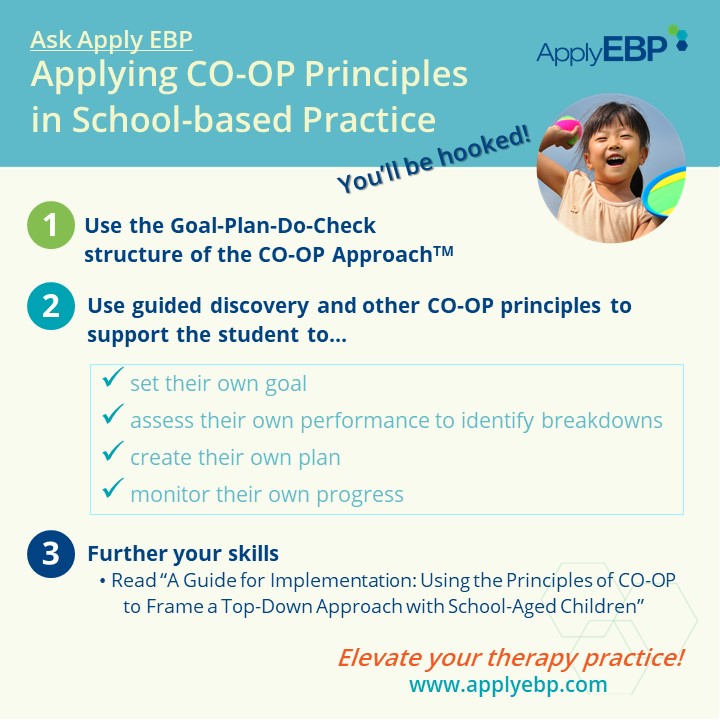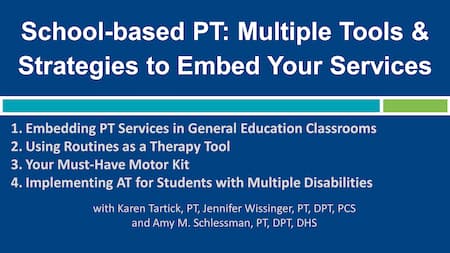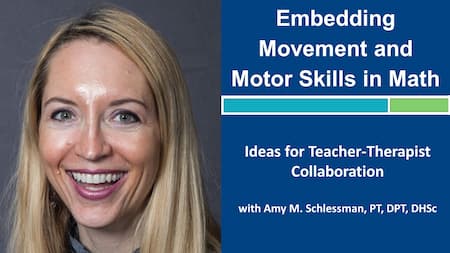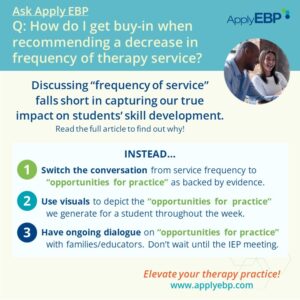Ask Apply EBP
5 Skilled Services We Can Provide When Embedding in the Student’s Real-life Environment
Question: I often feel I’m providing unskilled work when embedding my services into the classroom. Do you have any suggestions?
Let me start by saying that, yes, embedded service is a skilled service!
We now know that embedding is a service delivery model that is considered ideal practice (Effgen & Kaminker, 2014), and it works! Here is a sampling of what recent research articles have to say about providing services in real-life context:
-
-
- “Skills-based training and therapeutic practice in the context of valued occupations are recommended over isolated sensorimotor approaches.” (Cahill and Beisbeir, 2020)
- One key ingredient of an effective intervention is “practice of real-life activities in natural environments to optimise the child’s learning and the variability of the practice.” (Novak and Honan, 2019)
-
Wow, these are basically describing/supporting the efficacy of embedding your services in the child’s natural environment. If embedded service works then why do we often feel unskilled when providing embedded services?
What We Value As Skilled Service
The question above probably says more about what we (and others around us) value as skilled service, and what we do not.
Perhaps, what many of us have learned to value, over the years, as skilled service is delivering a more-or-less planned intervention in the controlled environment of a “therapy space” within, say, 30 minutes of therapy. It is that intervention that makes us feel we have directly instructed the child towards completion of the task. It is that intervention that once done, gives us that satisfaction that, “Yes! I helped Johnny improve in XYZ during my session!”
There are big problems with this narrow view of skilled service.
-
- First, it would be difficult to provide the service delivery method described above when embedding ourselves into the student’s real-life environment. The classroom is far from being a controlled environment like our therapy space. And this is a common frustration about embedded service, that one cannot provide the same intervention they were providing in the therapy space, when they are embedding.
- Second, the above example limits seeing progress within that controlled environment. It does not demonstrate generalization of skills into the child’s natural environment (e.g., think about that student that can write well in the therapy room, but not during journal time in the classroom). There are other skilled services that we can provide, many of which focus more on generalization of skills in real life!
Before we can venture into what can be considered a skilled service, let’s take a look at what our national organizations say about our professions:
-
-
- “Physical therapists are health care professionals who help individuals maintain, restore, and improve movement, activity, and functioning, thereby enabling optimal performance and enhancing health, well-being, and quality of life.” (APTA Guide to PT Practice, 2014)
- “[O]ccupational therapy is defined as the therapeutic use of everyday life occupations with persons, groups, or populations (i.e., the client) for the purpose of enhancing or enabling participation.” (OT Process Framework-4, 2020)
- “Speech-language pathologists (SLPs) work to prevent, assess, diagnose, and treat speech, language, social communication, cognitive-communication, and swallowing disorders in children and adults.” (ASHA, n.d.)
-
While those are just excerpts, even if you read the rest of the content within the links provided above, nowhere does it say that our service should always be one-on-one nor delivered in a separate therapy space. In fact, what these documents do describe are a variety of ways to deliver our services.
So, to feel that we are providing skilled service while embedding, we need to widen our view of skilled services!
Overlooked and Underappreciated Skilled Services
When embedding ourselves, we need to embrace other ways of providing skilled service, such as
-
-
- Skilled Observation
- Coaching
- Environmental Interventions
- Assistive Technology/Adaptive Equipment
- Co-Teaching
-
Often we see these as “extras” that augment our “real intervention done in our therapy space” (such as the one I described above). But I’m urging you now to see these as just as valuable, if not more valuable, to be effective in the child’s learning and generalization of skills.
Until we appreciate these as skilled services, nobody else will!
Let’s discuss one at a time how these services require our unique expertise, knowledge, training, and clinical decision-making to create and deliver meaningful interventions and help a student succeed.
1. Skilled Observation
It is natural to appear and/or feel like we are not doing anything skilled when observing. From a decision-making and outcomes perspectives, however, we can see how observation is a skilled service because it allows us to…
-
-
- Understand the student’s routine with their peers in a natural environment.
- For example, you know that Marco can stand up from the floor easily using the Timed Floor to Stand test, and you don’t get why the teacher is reporting that Marco has a problem with this. When you observed their classroom circle time routine, you realized that the students transfer between standing and sitting on the floor at least 3 times. Marco does well the first time, sort of ok the 2nd time, but was having problems the 3rd time. A-ha! It is not the sit-to-stand skill that’s a problem, but the endurance to do it over and over again in a short period of time!
- Perform a task analysis “in vivo” and figure out the supports and barriers to the child’s performance and participation.
- You can learn that the barriers to the child’s participation does not just lie in the child him/herself, but it can lie in the environment or the task that is given in the classroom. This can help you realize other interventions, such as tweaking the environment or the task, to enable the child to participate right away. For example, you realize that Marie gets the 1st and 2nd steps of a task in the classroom, but forgets the rest of the steps. You may then try a visual schedule to augment the her working memory, and allow her to complete the task.
- Be familiar with the classroom dynamics and potential collaborators for carryover of strategies.
- You may realize, for example, that a strategy you provided Anita (a classroom staff) was not being carried over because a different classroom staff works with Johnny depending on the day or time of day (not just Anita!). By observing, you figured out who else will need your coaching.
- Understand the student’s routine with their peers in a natural environment.
-
How do you perform observations that are skilled? Here are some examples:
-
-
- Observations On-the-fly
- These are quick and informal that happen during the course of your being in the classroom. For example, when you observe what Johnny is doing during a cutting activity.
- Thorough Observation
- This is also often called an Ecological Assessment. Click here to learn more about it and to learn how to get a Free copy of an Ecological Assessment Form.
- These take longer and are documented in detail to provide an understanding of what happens in the real environment. For example, at the start of the year, it is ideal to spend more time observing to be acquainted with the class dynamics and expectations, and how the child functions in the new setting. You might think you are not doing anything skilled because you are not providing “hands-on interventions”, but you are actually gathering lots of information so you can make good clinical decisions as to what interventions may work best for the child.
- Observations to Monitor Effectiveness of Interventions
- These are even more formal observation to capture any change in performance. These can be done especially when you are trying out an intervention that does not yet have strong evidence behind it. For example, if you have the student, Eric, use a sensory strategy to improve his attention to task during the 20 minutes of reading time. You can get a baseline by observing Eric for those 20 minutes, checking off on a chart whether Eric is “reading” or “doing something else” every 60th second for a total of 20 data points. Two weeks later, you would do the same formal observation to see if the number of times Eric is observed “reading” increases.
- Observations On-the-fly
-
To ensure that your classroom colleagues understand that your observation is “skilled” (i.e., you’re not just sitting/standing around), take the time to explain the what, when, where, why and how of your observations. Document and discuss your findings with your team.
2. Coaching
Coaching has become a catch-all term for when we speak with others, that it has almost lost its meaning and value as a skilled intervention.
It is easy to assume that when we sit down with a teacher and give them suggestions that we are coaching, when more likely, we are just “couching” – an unforgettable term I learned from Jen Wissinger, PT, DPT in her Coaching as a Therapy Tool webinar.
So what actually is Coaching?
In the SeekFreaks article The 6 Steps of Coaching Our Clients, Peggy Morris, OTD, OTR/L, BCP, states coaching “uses a conversational format that is goal-focused and relies heavily on the practitioner’s ability to provide reflective prompts rather than provide answers, so that, in the end, the clients, whether they are parents, students themselves, or teachers drive the intervention process.”
Ahhh! That’s very different from what I thought was coaching. If you want to learn how to coach step-by-step, read Peggy’s free article here or watch Jen’s webinar here. You can use their step-by-step strategies when coaching school staff on anything, from tabletop activities, to self-care, to use of playground equipment, and others.
Hmmmm…you might be thinking right now, how can you do coaching as an embedded service? Doesn’t coaching require a quiet separate space for conversation?
In fact, coaching is best done embedded in the real-world performance of a task, and not in a quiet separate space for conversations (as you will learn from Peggy’s article and Jen’s webinar). This way, together you can observe how the child performs an activity, explore options for improved performance, try out these different options, and decide which one is best to implement every day. This is very different from just listing suggestions that they may “try at a later time” – which we know more often than not, would never be tried for various reasons.
You can also provide coaching to the student using the CO-OP Approach’s Goal-Plan-Do-Check. For more information, read this free article by Lara Barros on Applying CO-OP Principles in School-based Practice.
3. Environmental Interventions
Disability occurs when there is a mismatch between a person and the environment!
Therefore, we need to look at the physical and social environment via the skilled observation described in #1 above, and see how we can modify them to support the student’s function.
More often than not, environmental factors are more malleable than a child’s body function and structure. With simple tweaks to the environment to make it more accessible and supportive of function, you can promote instant participation!
Think of Ken who always takes longer than his peers when putting away his lunchbag into his cubby after lunch. Upon observing, you realize that Ken has a hard time lifting his lunchbag into his cubby, likely due to any or all of these: muscle weakness, limited range of motion, or his cubby being too high. Which one will result in the instant ability to put his lunchbag away…Strenghthening his arms? Increasing his range of motion? Or giving him a lower cubby? Likely, the latter!…which is a simple tweak in the environment.
When thinking of the environment, don’t forget to look at the social environment. This includes the ABCs of attitude, behavior and culture…of the school, the classroom, the staff, the teacher and the student’s peers. Do you need to intervene, say,
-
-
- By providing school staff with a training on a student’s health condition and their accessibility needs?
- By advocating for implementing ways to match the expectations to the student’s strengths, abilities and interests?
- By promoting social interactions during mealtime by sitting the student with her peers with similar interests?
-
4. Assistive Technology/Adaptive Equipment
Assistive technology/adaptive equipment is for everyday use, so this is also ideally provided via embedding. When considering AT/equipment as part of your intervention, think of the embedded time you need for the following:
-
-
- Exploring and trying out AT options
- Modeling and training on use of AT
- Monitoring use of AT
- Problem-solving issues with use of AT
- Motivating staff and student on continued use of AT
- Monitoring effectiveness of AT
- And more
-
The above are true whether you are considering something big (e.g., stander during music time, an alternative communication device for social interaction, or a digital device for journal writing), or you are considering something smaller, such as a slant board, a pencil grip, or lunch trays with better grips. Don’t assume that since they are small, you can just leave the AT and hope for the best that it works. You still need to do many or all of the above!
5. Co-teaching
If you’re comfortable with the first 4 above, and are ready to up the ante, embedded service time can also be provided via Co-teaching.
There are different ways to co-teach. Here are some examples:
-
-
- Co-teaching via a Station during Centers time – you can design activities for gross motor, fine motor, or language activities based on the needs of the students
- Co-teaching movement break activities – here are some ideas from a SeekFreaks article, Let’s Move More in Schools…in Just 3 Steps! by Katie Fain, DPT, a school-based PT from Northern Michigan
- Co-teaching movement activities that can be embedded into the teacher’s lesson, say for example in Math, Science or Literacy…great ideas from Amy Schlessman, PT, DPT, DHSc.
- Parallel co-teaching during reading time, where an SLP can work with a group of students with language needs, while the teacher works with the other students in “parallel”
- Get more ideas in the webinar, Practical Strategies for Embedding Interventions into School Environments by Pam Stephenson, OTD, OTR/L, BCP, FAOTA
-
Don’t forget than when co-teaching, you would also need to set aside time to co-plan with the teacher. And take the opportunity given by co-teaching to model to the teacher how they can embed OT-ish/PT-ish/SLP-ish strategies in future lessons.
Sharing the Value of Embedded Services with Others
I hope by now that you are convinced that many of the things we do when embedding are skilled interventions…from observations to co-teaching! They require our expertise, knowledge, training, and decision-making skills. Yes, they are skilled!
Now that you are convinced, it is time to ensure that others are also convinced, and that you get credited for your time and effort providing embedded services. Here are some Think Abouts!
-
-
- Give a quick presentation to your school team and parents on Embedding Services, including the whys and the hows. Tout its value as a skilled intervention that you deliver. Feel free to use any part of this article, including the infographic in your presentation
- Include the time you need for embedded interventions in the student’s IEP.
- Don’t shortchange yourself! Embedding takes time, as my sample list of to-dos for AT above illustrates.
- Depending on the type/details of your intervention and your school’s regulations, the time can go on the “Related Services” page of the IEP. Or in some instances, the time goes better on the “Supplementary Aids and Services (SaS)”. Or you may need to divide up the time into both sections of the IEP. (You can learn more fromt he webinar, Supplementary Aids and Services by Sue Cecere, PT, MHS.)
- Advocate with your school administrators to set aside time in your schedule for work needed to embed successfully that may not count as service time on the IEP.
- For example, can you be allowed to set aside 30 minutes a week to co-plan to co-teach PE? Or to set aside 30 minutes a month to address AT maintenance issues?
- One step above #3 is to advocate for a Workload Model.
- Compared to a Caseload Model, a Workload Model goes beyond just counting the number of students with IEPs, but takes into account other tasks and factors, such as time for collaboration, travel, documentation, etc.
- For more information, read Peggy’s SeekFreaks’ article 4 Easy Steps to Advance from a Caseload to a Workload Approach.
-
We can’t finish this discussion, without touching upon billing. Note that each state has its own billing guidelines, so I cannot make any generalizations here. Make sure to refer to your state’s regulations, so you can bill for service minutes that you can justifiably bill for. This applies to any interventions you provide, including those delivered in an embedded manner.
Note that not every minute of what you do to help a student succeed in school is billable, and that’s why you need to advocate as discussed in the 3rd and 4th Think Abouts above. If you want to learn more about Medicaid, read Laurie Ray, MPT, PhD’s SeekFreaks Medicaid in Education, article or watch her Medicaid, Plan of Care and Documentation webinar.
I hope this article has given you the confidence and reassurance that you are providing skilled interventions when embedding! Try them out. Happy Embedding!
If you wish to gain more strategies for embedding, join…
REFERENCES
Cahill, S. M., & Beisbier, S. (2020). Occupational therapy practice guidelines for children and youth ages 5–21 years. The American Journal of Occupational Therapy, 74(4), 7404397010p1-7404397010p48.
Effgen, S. K., & Kaminker, M. K. (2014). Nationwide survey of school-based physical therapy practice. Pediatric Physical Therapy, 26(4), 394-403.
Novak, I., & Honan, I. (2019). Effectiveness of paediatric occupational therapy for children with disabilities: A systematic review. Australian occupational therapy journal, 66(3), 258-273.
Got other ideas or questions about embedding? Comment below!
Find More Answers to Your Questions in Our...
Featured School
Symposium
7th Online School-based OT and PT Symposium - On-Demand Version
- Watch and re-watch on your own time
- On-Demand Version
- OTs, OTAs, PTs and PTAs
- $399-449
Featured Live
Workshop
6th Online School-based OT and PT Symposium - On-demand Version
- Watch and re-watch on your own time
- On-Demand Version
- OTs, OTAs, PTs and PTAs
- $399-449
Featured On-Demand
Webinar
Embedding Movement and Motor Skills in Math
Featured Webinar
Bundle
School-based PT: Embedded Interventions Bundle
Have a question?
Submit here…
*Clicking submit will send your question directly to our email inbox. Your name and email will let us know that your submission is real (not spam). We will not include these in our posts, unless you tell us to include your name. Please read our privacy policy here.
All infographics and videos on www.applyebp.com are intellectual properties of Apply EBP, LLC
You may use the infographics and videos for free for any non-commercial, educational purposes. Please cite the source as “Apply EBP, LLC” and a link to the source article. If you plan to use any infographic or video for commercial purposes (i.e., for profit), please email Carlo@applyebp.com to obtain a written permission. Permission can be granted on a case-by-case basis.











